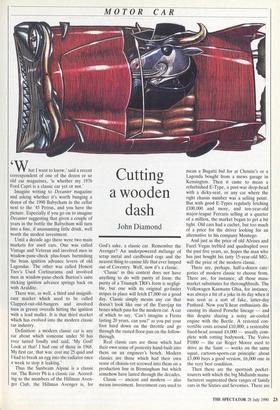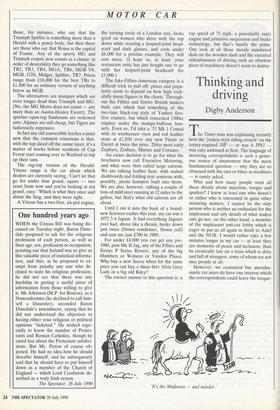MOTOR CAR
Cutting a wooden dash
John Diamond
W hat I want to know,' said a recent correspondent of one of the dozen or so old car magazines, 'is whether my 1976 Ford Capri is a classic car yet or not.'
Imagine writing to Decanter magazine and asking whether it's worth bunging a dozen of the 1990 Babycham in the cellar next to the '45 Petrus, and you have the picture. Especially if you go on to imagine Decanter suggesting that given a couple of years in the bottle the Babycham will turn into a fine, if unassuming little drink, well worth the modest investment.
Until a decade ago there were two main markets for used cars. One was called Vintage and Veteran and involved men in window-pane-check plus-fours burnishing the brass ignition advance levers of old Lagondas. The other was called Honest Trev's Used Cortinarama and involved men in window-pane-check Burton's suits sticking ignition advance springs back on with Araldite.
There was, as well, a third and insignifi- cant market which used to be called Clapped-out-old-bangers and involved men in greasy overalls hitting the ignition with a lead mallet. It is that third market which has evolved into the modern classic car industry.
Definition: a modern classic car is any car about which someone under 50 has
ever tutted fondly and said, 'My God! Look at that! I had one of those in 1968. My first car, that was: cost me 25 quid and I had to break an egg into the radiator once a week to stop it leaking.'
Thus the Sunbeam Alpine is a classic car. The Rover P6 is a classic car. Accord- ing to the members of the Hillman Aven- ger Club, the Hillman Avenger is, for God's sake, a classic car. Remember the Avenger? An 'underpowered mélange of scrap metal and cardboard cogs and the nearest thing to canine life that ever limped out of Coventry. Well, now it's a classic.
'Classic' in this context does not have anything to do with purity of form: the purity of a Triumph TR8's form is negligi- ble, but one with its original go-faster stripes in place will fetch £7,000 on a good day. Classic simply means any car that doesn't look like one of the Eurojap tin boxes which pass for the modern car. A car of which to say, 'Can't imagine a Fiesta lasting 20 years, can you?' as you put your foot hard down on the throttle and go through the rusted floor-pan on the follow- through.
Real classic cars are those which had their own sense of posterity hand-built into them on an engineer's bench. Modern classics are those which had their own sense of chassis-rot screwed into them on a production line in Birmingham but which somehow have lasted through the decades.
Classic — ancient and modern — also means investment. Investment cars used to
mean a Bugatti bid for at Christie's or a Lagonda bought from a mews garage in Kensington. Then it came to mean a refurbished E-Type, a post-war drop-head with a dicky-seat, or any car where the right chassis number was a selling point. But with good E-Types regularly fetching £100,000 and more, and ten-year-old major-league Ferraris selling at a quarter of a million, the market began to get a bit tight. Old cars had a cachet, but too much of a price for the driver looking for an alternative to his company Montego.
And just as the price of old Alvises and Facel Vegas trebled and quadrupled over the past five years, so, hopes the man who has just bought his tatty 15-year-old MG, will the price of the modern classic.
There are, perhaps, half-a-dozen cate- gories of modern classic to choose from. There are, for instance, all those mass- market substitutes for thoroughbreds. The Volkswagen Karmann Ghia, for instance, was always a bit of a joke in its day when it was seen as a sort of fake, latter-day Panhard. Now you'll hear enthusiasts dis- cussing its shared Porsche lineage — and this despite sharing a noisy air-cooled engine with the Beetle. A restored con- vertible costs around £10,000; a restorable fixed-head around £4,000 — usually com- plete with rotting bodywork. The Volvo P1800 — the car Roger Moore used to drive as the Saint — works on the same squat, cartoon-sports-car principle: about £3,000 buys a good version, £6,000 one in the very best condition.
Then there are the sportyish pocket- tourers with which the big Midlands manu- facturers augmented their ranges of family cars in the Sixties and Seventies. There are
MOTOR CAR
those, for instance, who say that the Triumph Spitfire is something more than a Herald with a poncy body, but then there are those who say that Rome is the capital of France. Any of the sporty MG and Triumph coupes now counts as a classic: in order of desirability they go something like TR2, TR3, TR4, MGA, TR6, MGB V8, MGB, GT6, Midget, Spitfire, TR7. Prices range from £18,000 for the best TRs to £1,800 for an ordinary version of anything below an MGB.
The alternatives are marques which are even longer dead than Triumph and MG. (No, the MG Metro does not count — any more than an Austin-Healey Escort). The sportier open-top Sunbeams are reckoned cars: Alpines are still cheap, but Tigers are ludicrously expensive.
In fact any old convertible fetches a price now that the common consensus is that, with the top sliced off the ozone layer, it's a matter of weeks before residents of Cap Ferrat start coming over to Watford to top up their tans.
The rag-top version of the Herald- Vitesse range is the car about which dealers are currently saying, 'Can't let that go for under four grand, squire — two years from now and you're looking at ten grand, easy.' Which is what they once said about the Stag, and they were right.
A Vitesse has a two-litre, six-pot engine, the turning circle of a London taxi, looks good on women who drive with the top down while wearing a leopard-print head- scarf and dark glasses, and costs under £6,000 for a pristine example. They will cost more. (I hope so, at least: your restaurant critic has just bought one to go with her leopard-print headscarf for £3,000.) The fake-Fifties-American category is a difficult trick to pull off: prices and popu- larity seem to depend on how high rock- abilly music figures in the charts. Through- out the Fifties and Sixties British makers built cars which had something of the two-lane black-top style of Yankee five- litre cruisers, but which concealed 1300cc engines under the stumpy-bulbous bon- nets. Even so, I'd take a '53 Mk 1 Consul with its windscreen visor and red leather seats at £1,850 over any new Fiesta or Escort at twice the price. Ditto most early Zephyrs, Zodiacs, Minxes and Corsairs.
An easier decision is to go for what the brochures now call Executive Motoring, and what were then called large saloons. We are talking leather here, with walnut dashboards and folding rear armrests with, possibly, picnic hampers built into them. We are also, however, talking a couple of tons of mild steel running at 12 miles to the gallon, but that's what old saloons are all about.
Until I ran it into the back of a brand- new Scirocco earlier this year, my car was a 1972 3.4 Jaguar. It had everything Jaguars ever had, drove like a dream, broke down just twice (blown condenser, blown coil) and cost me just £700 in 1989.
. For under £4,000 you can get any pre- 1980, post Mk II Jag, any of the Fifties and Sixties P Series Rovers, any of the big Humbers or Wolseys or Vanden Plases. Why buy a new Sierra when for the same price you can buy a three-litre Alvis Grey Lady or a big old Riley?
The correct answer to this question is: a top speed of 75 mph, a potentially rusty engine and primitive suspension and brake technology, but that's hardly the point. One look at all those sternly numbered dials on the wooden dash and the essential ridiculousness of driving such an obsolete piece of machinery doesn't seem to matter.



















































 Previous page
Previous page